“Blinding, fierce, shockingly electric. A running hair dryer has just been dropped into your bubble bath.
A bolt out of the heavens. Lie down and scream”.
Such is the evocative description of the pain inflicted by the sting of the insect that rates a solid four by Dr Justin Schmidt the famed entomologist and creator of the Schmidt Pain Index for insect bites and stings. Only the Bullet Ant and Warrior Wasp of South America rate higher. He goes on further to describe the pain as being “so debilitating and excruciating that the victim is at risk of further injury by tripping in a hole or over an object in the path and then falling onto a cactus or into a barbed-wire fence. Such is the sting pain that almost nobody can maintain normal coordination or cognitive control to prevent accidental injury. Screaming is satisfying and helps reduce attention to the pain of the sting.”
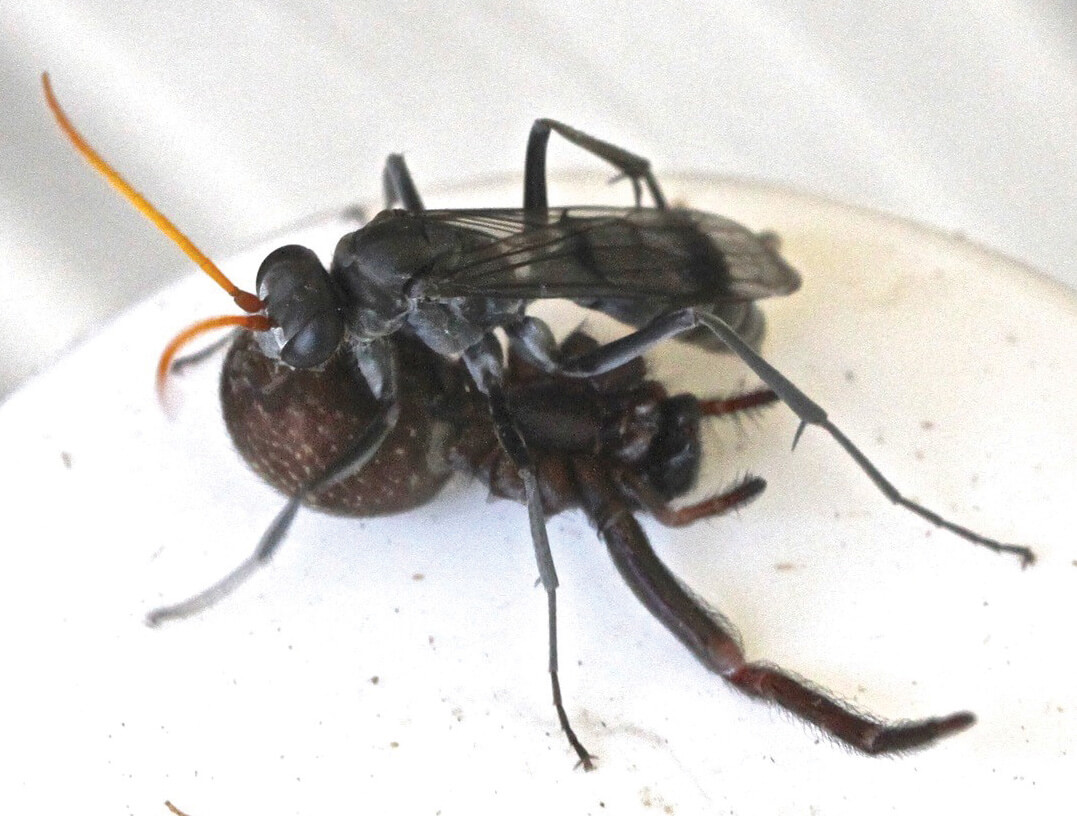
And here I was with my nose only centimetres from this fearsome creature as she dragged her latest victim to a grisly doom. Just what was I thinking?
The ‘creature’ in question was a beautiful female Tarantula Hawk and her ‘victim’ was a spider. Luckily for me they have to be seriously provoked to elicit a sting, unlike their feistier colony defending wasp cousins.
Tarantula Hawks are the largest wasps in the Family Pompilidae and can grow to an impressive 5cm, but in Australia they ‘only’ manage to reach 3.5cm. Wasps in this family are all solitary wasps, have a worldwide distribution and are found in a wide range of habitats. They come in various colours that are usually based on black, orange and yellow. The Tarantula Hawk that I’d watched had a shiny black, almost metallic body with beautiful orange wings.
Collectively, the Pompilidae are called spider wasps due to their reliance on spiders as a food source. This spider meal however isn’t for the mature wasps which are gentle herbivores, feeding as they do on the nectar of flowers and fermented fruit. Instead, it is their offspring that are carnivorous, and this is how I knew that the Tarantula Hawk that I’d encountered was a female – only females use their fearsome sting on spiders as they take on the risky business of hunting spiders for their babies.
Female spider wasps catch, paralyse and then drag spiders back to a burrow. There, they lay one egg on the spider for their young to feed on.
Photos by John Anderson.
Despite hunting spiders that are usually many times their size and that are themselves ferocious predators, it is the wasp that inevitably comes away victorious when they come together in what are often epic battles. When hunting for spiders, females are constantly on the move, darting around, flicking their wings, tapping their antennae on the ground and doing short restless flights before starting the hunt again. As I watched my Tarantula Hawk she continued dragging the spider over every obstacle in her path using her characteristically long legs and never ending ‘nervous’ energy to a pre-dug hole. If the spider is especially large, spider wasps will sometimes bite the spider’s legs off to make transport easier. Smaller spiders they will pick up and fly off with.
Arriving at her hole she dumped the spider at the entrance and with a flick of her wings disappeared inside only to quickly reappear, grab her spider and drag it underground. There, unseen, she laid a single egg on the hapless spider, again emerged, sealed her baby inside and flew off.
As well as digging purposely excavated holes, as I’d seen, or utilizing existing crevices for their spider prey they will also repurpose a spiders’ already dug burrow and turn it into their own baby incubator, restaurant and crypt. They either hunt spiders that are already out in the open, or if the spider is in its burrow, spider wasps will either try and entice the spider out, or they may fearlessly plunge into the spider burrow to do battle underground.
It was a spider wasp that eventually ended the life of the world’s oldest known spider, a 43-year-old Australian trapdoor that was found dead in its burrow after being the subject of years of constant study.
Some spider wasp species dispense with the stashing of their spider prey and simply lay an egg on the paralysed spider wherever it was stung. An even smaller group are klepto-parasites that steal the already paralysed spider from other spider wasps onto which they then lay their own egg.
For every spider wasp born a spider has died – and what a gruesome death it is.
The deposited egg hatches after 3-4 days and the larva starts to feed on the spider. This is where the gruesome part comes in as the developing wasp larva requires the spider to remain fresh as it needs to grow and moult through several instars before finally pupating and emerging as a mature wasp. Two strategies are employed to ensure the freshness of the meal. Firstly, the spider isn’t killed in the struggle between the spider and the wasp. The spider that I’d observed being dragged along as a ‘dead’ weight wasn’t dead at all but had been stung and paralysed by the female wasp. Secondly, the larvae are selective in the order in which they consume their meal. They carefully munch around the vital organs of the still live spider, thus keeping it alive until the final instar stage which devours the rest of the spider before pupating.
Male spider wasps are normally a bit smaller than females. They don’t need the physical size or strength to hunt spiders, but instead spend the two months of their adult life feeding and defending their territory from other males and attempting to mate with females.
Female spider wasps, like other members of the Order Hymenoptera (ants, wasps, bees and sawflies) are able to determine the sex of her offspring. To this end she will selectively fertilise an egg using stored sperm to produce a female or deposit an unfertilised egg to produce a male. Sex selection isn’t simply random as the female wasp will deliberately choose the sex of her offspring depending on the size of the spider she has hunted. Larger spiders are selected for females. They, after all, are required to do all the dangerous and hard work of spider hunting, tunnel digging and dragging to ensure that the next generation of spider wasps is produced.
Top photo: Female spider wasps can choose the gender of their offspring by choosing to deposit a fertilised or unfertilised egg. They will generally choose a fertilised (female) egg if they have caught a large spider, such as this huntsman spider shown here. Photo by John Anderson.
Article by Tony Mlynarik
Land for Wildlife Officer
Brisbane City Council
References and Further Reading
https://www.aboutanimals.com/insect/tarantula-hawk/
http://anic.ento.csiro.au/insectfamilies/
Schmidt JO (2016) The Sting of the Wild. Johns Hopkins University Press.
https://www.thoughtco.com/tarantula-hawks-genus
Mason LD, Wardell-Johnson Grant, Main BY (2018) The longest-lived spider: mygalomorphs dig deep, and persevere. Pacific Conservation Biology 24, 203-206.
https://australianmuseum.net.au/learn/animals/insects/spider-wasps/

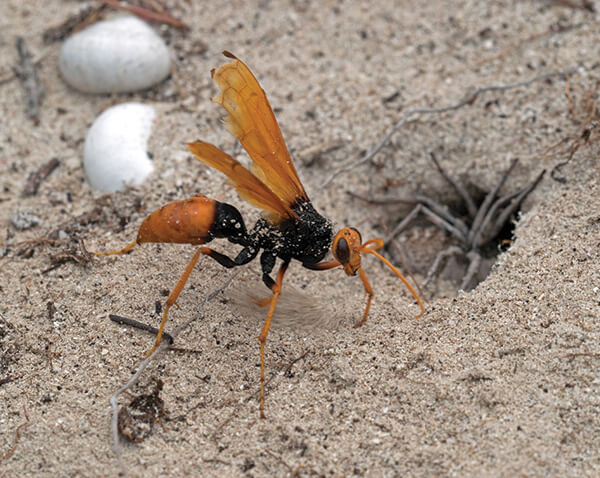
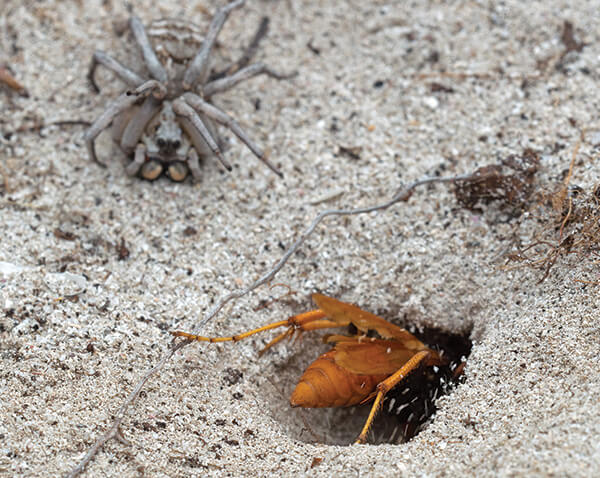
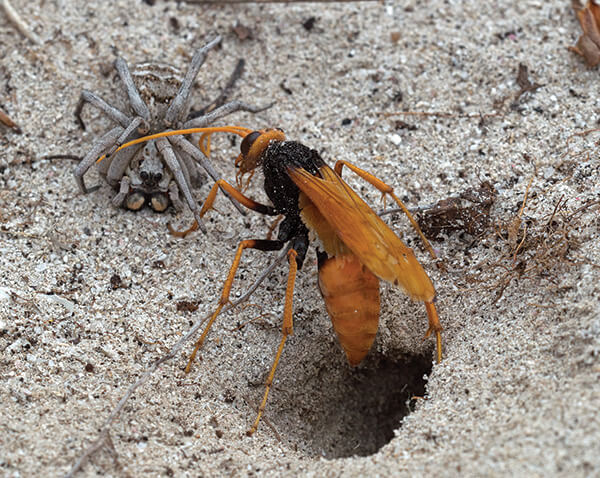
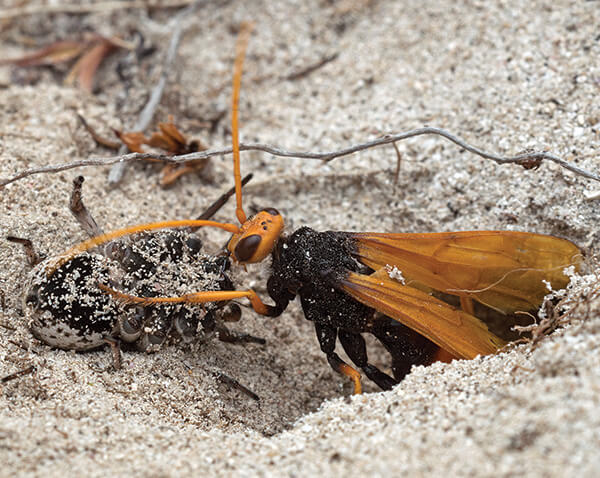
I have a couple of spider wasps in my back garden at home in small SA country town. They fly or hop and dig small holes individually close to a couple of fruit trees. There are several spiders and webs around house and nearby shed. Will they attack fruit trees which are starting to bear fruit?